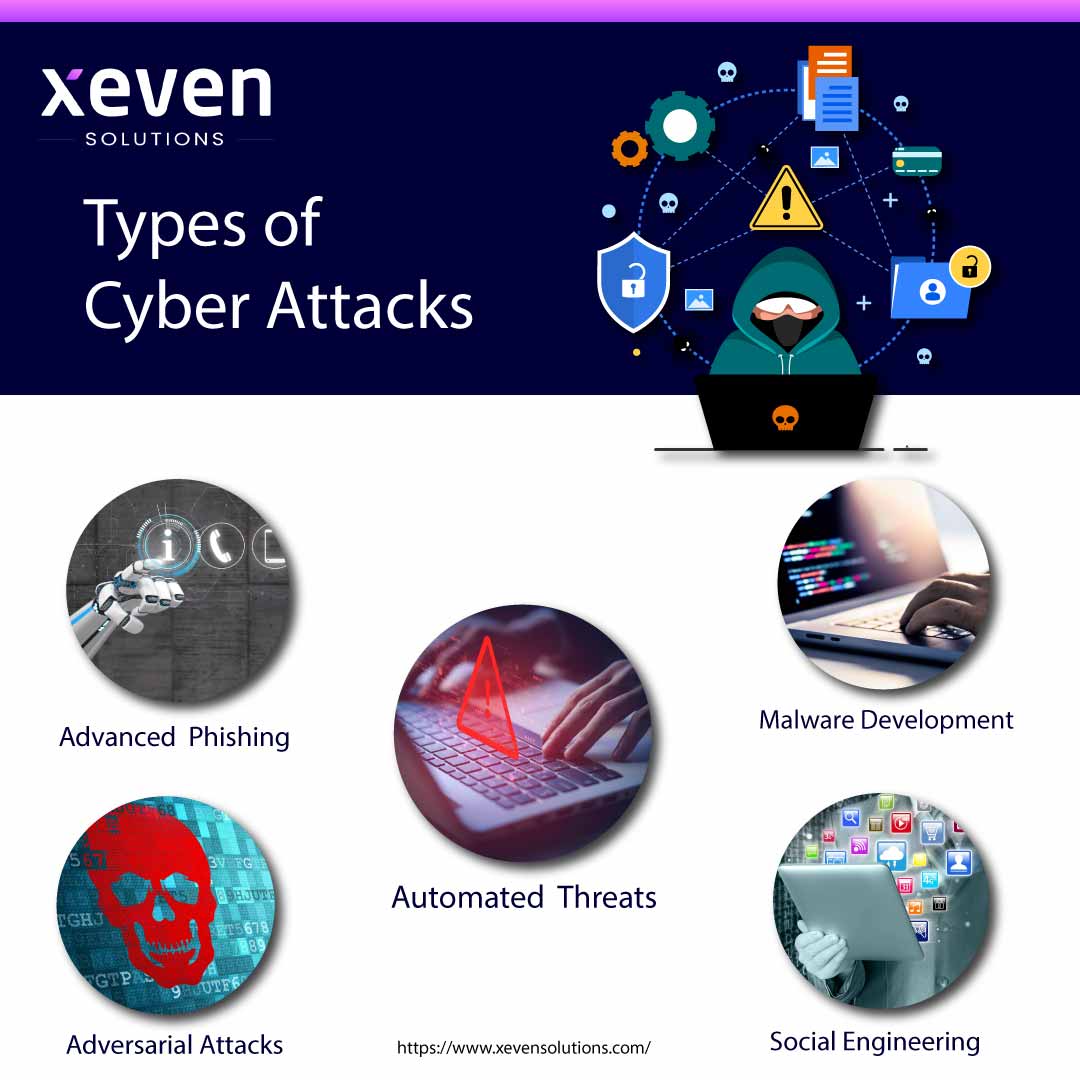

January 17, 2024
The danger of artificial intelligence cyber attacks is rapidly increasing with the rise of new Artificial Intelligence (AI) technology. Hackers are increasingly using AI in cybersecurity to carry out clever attacks that are hard to spot and protect against. Organizations must grasp the associated risks and implement measures to alleviate them.

AI cyber attacks refer to malicious activities in the digital realm that use Artificial Intelligence to carry out or enhance various cyber threats. In these attacks, AI is employed by hackers to automate and optimize different aspects of the attack process. AI helps them make these attacks more sophisticated, adaptive, and difficult to detect.
These attacks can encompass a wide range of strategies, such as:
AI algorithms are used to create and deploy automated tools that can rapidly scan and exploit them without human intervention.
AI can be utilized to generate highly convincing phishing emails or messages that are personalized, making it more likely for individuals to fall victim to them.
AI in cybersecurity streamlines the creation of malware by adapting its code and behavior based on the target environment. This makes it harder for traditional security measures to counteract.
AI algorithms can be manipulated to deceive other AI systems, leading to misclassifications, false positives, or evading detection mechanisms.
In social engineering attacks, vast amounts of data are analyzed using AI to develop tailored strategies. These attacks aim to manipulate individuals by delivering messages that are personalized and highly convincing.

Artificial intelligence cyber attacks use machine learning to evaluate potential vulnerabilities in both human and machine targets. These targets help AI to strategically identify tactics that pose the greatest risk to an organization’s security. This could entail creating deceptive emails by drawing insights from individuals’ social media profiles or utilizing information to anticipate weaknesses in a target system and carry out an attack.
These attacks are usually focused and can outsmart regular cybersecurity measures that may not be adequately equipped to detect them.
Previously effective strategies, like analyzing email content for misspellings or grammar errors, or detecting anomalies in machine-generated scans, have become obsolete in the face of these sophisticated AI-driven threats.
A primary concern with AI and cyber security is their capacity to learn and adapt to new defense mechanisms. Regular cybersecurity depends on identifying familiar patterns and signatures to prevent attacks. However, AI-powered attacks can learn from these defenses and devise innovative methods to evade them. This highlights the need for organizations to continually adjust their cybersecurity measures to address these evolving threats.
Another significant risk associated with rise of AI-powered cyber-crime is their potential for causing widespread damage. These attacks can target critical infrastructure, including power grids and transportation systems, leading to disruptions in entire economies.
Additionally, they can steal important information such as financial data and intellectual property, leading to lasting consequences for both organizations and individuals. Effectively countering these threats requires a comprehensive approach to AI and cybersecurity.

With the rise of AI-powered cyber-crime, organizations face an increasingly dynamic landscape of digital threats. As artificial intelligence technology becomes more prevalent, cyber attackers use its capabilities to advance attacks. Mitigating the risks associated with these threats requires a proactive approach.
Regularly monitor network activities and system behaviors to detect any unusual patterns or deviations. Implement adaptive cybersecurity measures that can evolve alongside the dynamic tactics employed by AI-powered cyber attacks. This involves staying informed about the latest threat intelligence and adjusting defense strategies accordingly.
Provide comprehensive training programs to educate employees about the evolving nature of AI in cybersecurity. Foster a culture of cybersecurity awareness to empower individuals to recognize and report suspicious activities. Emphasize the importance of exercising caution when interacting with emails, messages, and online content to prevent falling victim to social engineering tactics.

Deploy advanced threat detection solutions that use artificial intelligence and machine learning to identify potential cyber threats. These solutions can analyze large datasets, recognize anomalous behaviors, and detect patterns indicative of AI-driven attacks. Implementing cutting-edge technologies enhances the organization’s ability to stay ahead of sophisticated cyber threats.
Strengthen authentication processes and access controls to prevent unauthorized access to sensitive information. Implement multi-factor authentication (MFA) and ensure that employees only have access to the data and systems necessary for their roles. This limits the potential impact of a breach and adds layer of security against AI-powered attacks targeting credentials.
Develop and regularly update an incident response plan that outlines the steps to be taken in the event of a cybersecurity incident. This plan should include protocols for identifying and containing AI-powered threats and recovering affected systems. Conduct regular drills and simulations to ensure that the response team is well-prepared to handle different scenarios, minimizing the impact of potential attacks.
Xeven Solutions specializes in AI Development Services, focusing on advanced solutions for robust cyber attack defense. Using cutting-edge artificial intelligence technologies, Xeven creates innovative systems to detect and counteract evolving cyber threats. Our AI solutions enhance cybersecurity measures. We provide organizations with proactive defense mechanisms to safeguard against the sophisticated tactics employed by malicious actors in the digital landscape.
Organizations, regardless of size, face a significant threat from artificial intelligence cyber attacks. The belief that smaller businesses are immune is outdated, as these attacks are now highly targeted and capable of causing widespread harm. To mitigate risks, organizations should adopt AI-powered cybersecurity solutions, conduct regular security assessments, train employees, develop incident response plans, and collaborate with cybersecurity experts. As providers, it is our duty to educate clients on these risks and provide solutions for effective protection.